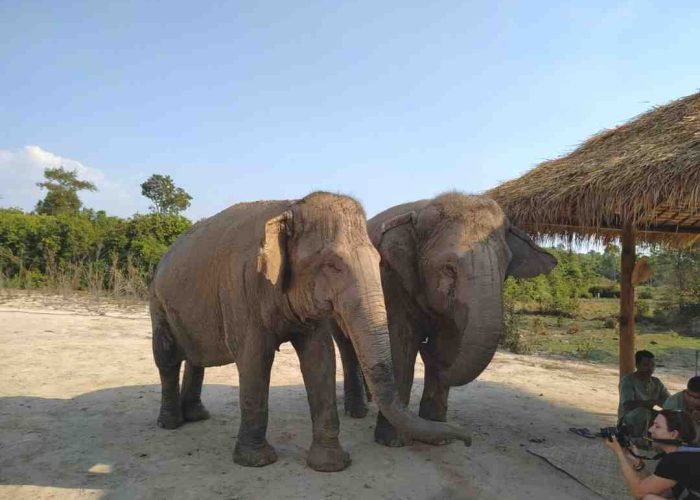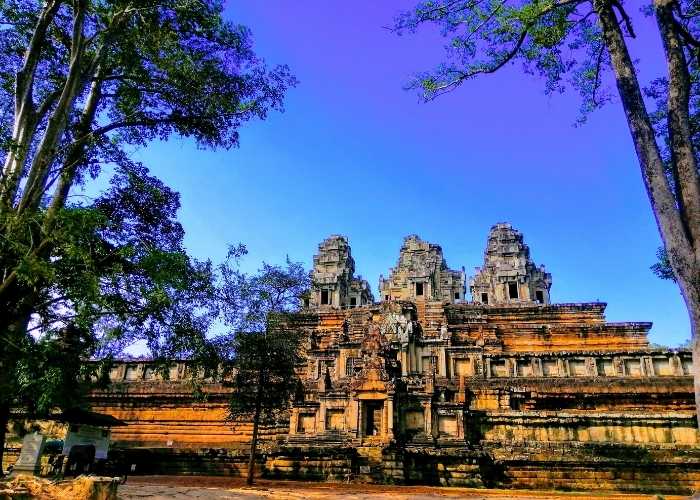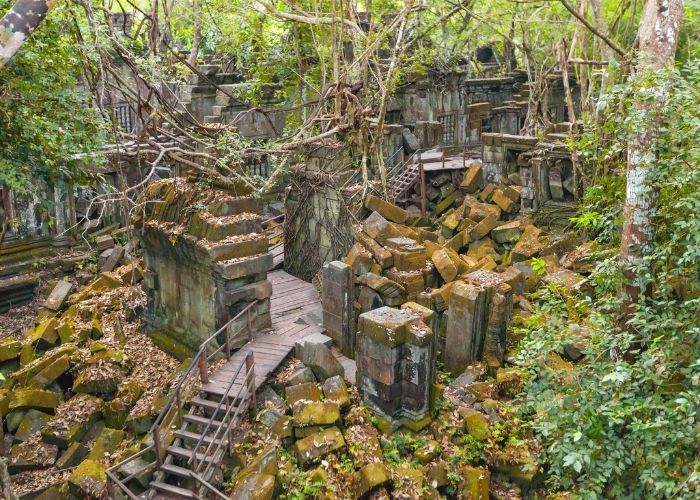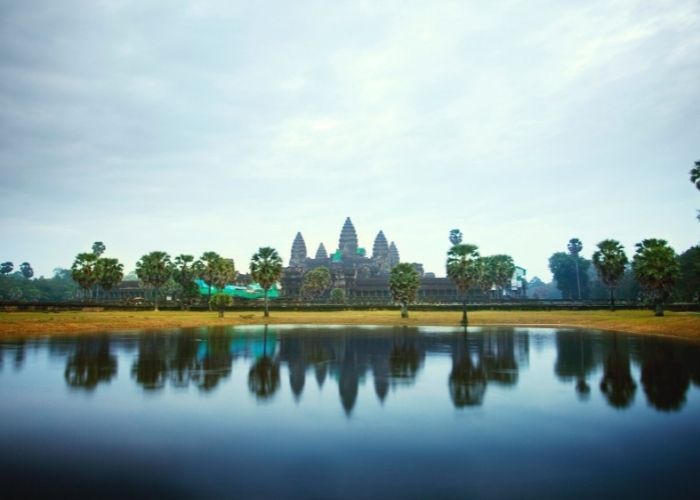Cambodia Wildlife Sanctuaries
I always wondered how I would feel if an elephant walked up to me. And now, thanks for this website and its articles on the subject of elephants in Cambodia!
And here is why Cambodia Wildlife Sanctuaries are amazing: Elephants can live there without humans harassing them or making their lives difficult like some people do with wildlife across other parts of the world where we don’t want anything interacting with us ever again because then what will happen when those animals become friends not enemies which leads into another question: why has nobody tried teaching these gentle giants human signs?
They may need help understanding language but surely even one word at time should suffice since they are so smart!
I was in Cambodia and wanted to see some elephants. Luckily for me there is an elephant sanctuary there with lots of them!


What's the best place to see elephants in Cambodia?
A sanctuary, of course!
The Cambodian Elephant Sanctuaries are home for over 100 wild and captive-bred Asian elephant individuals.
It has been estimated that there are fewer than 40 left on Earth today due primarily because humans keep stealing their land so they can build temples or farms where these giants once roamed free – but now you don’t have too as it provides protection from poachers who hunt them down like animals for their ivory tusks which fetch very high prices at marketplaces all across Asia (or crash markets if this starts hurting business).
The answer is that there are a few different options. You can visit a sanctuary which houses both domesticated beasts and wild ones from the forest, so everyone here will get an opportunity to spend some time playing with these huge mammals!
It sounds great on paper – but what’s really cool about it goes above and beyond anything you could have imagined: not only do they provide grass for their visitors’ feedings; when water resources run low due them being used primarily as agricultural animals (like most farms) they also plant more vegetation around their enclosure using recycled sewage sludge from human farming practices–creating habitats where none had existed before.
Where can I see elephants in Cambodia?
The number of wild elephants in Cambodia is presently believed to be between 400 and 600, with the majority of them concentrated in the Cardamom Mountains in south-western Cambodia and the eastern lowlands of Mondulkiri Province, according to official estimates.
Cambodia Wildlife Sanctuaries and Elephant Sanctuaries aim to protect and increase wild elephant populations throughout the nation in order to secure the long-term survival of the Asian elephant in Cambodia, which is threatened by poaching.
Are you looking for a place in Cambodia where you can see elephants in the wild?
Discover the best places to see elephants in Cambodia’s Elephant Sanctuaries and rehabilitation sanctuaries, and how to spot them.


Are there elephants in Siem Reap?
Are there elephants in Siem Reap? If so, you might like to know there are three main areas where they are found.
They are:
1. The Northern Plains
2. The Central Highlands
3. The Southern Hills.
And, if you happen to visit during July, there’s a fourth place you can go to see them… The Elephant Sanctuary Wherever they are, elephants are an inspiring and magnificent sight. It is hard not to be uplifted by the sheer power and majesty of these huge creatures. Many people don’t
The Bos Thom Community Forest is located on the slopes of Kulen Mountain, just 20-minutes from the Angkor Archeological Park. It is a protected area of 1100 acres that was once home to elephants from the Angkor Wat temple complex. These elephants have been providing rides to guests in the temples of this UNESCO World Heritage Site for 22 years.
The forest provides a home for the very same elephants that once towered over the jungle to provide pomp and circumstance for the rulers of the Khmer Empire.
Cambodia Elephant Sanctuary in Siem Reap
The Kulen Elephant Forest
The Bos Thom Community Forest, as we just saw, is a 1100-acre protected forest that was once home to elephants from the Angkor Wat temple complex. Here the Elephants are able to travel freely in their native environment and serve as living witnesses to a changing world.
Given the fact that there are only 75 captive elephants left in Cambodia, the preservation of this magnificent species is more important than ever.
We believe that education and tourism can be powerful drivers of conservation, and that a visit to the Kulen Elephant Forest will not only benefit the elephants of Angkor, but will benefit all elephants in Cambodia through the KEF’s longer-term objectives, because we believe in the power of education and tourism as drivers of conservation.


Mondulkiri Cambodia Elephant Sanctuary
Elephant Valley Project
The Elephant Valley Project is a public-private partnership. Since 2006, Mondulkiri Elephant Sanctuary has been recognized as Cambodia’s first and foremost elephant sanctuary.
Being a role model of conservation in the Nation and sanctuaries experience, Elephant Valley Project has precise goals:
- To enhance the health and wellbeing of Mondulkiri’s captive elephant population.
- To create a sanctuary in Mondulkiri Province for working elephants to recuperate and retire.
- To protect the natural habitat of wild elephants
- To give employment and job-training opportunities to the Bunong community and mahouts.
- To assist the local population in protecting their forest and natural resources, as well as the elephants’ habitat.
- Identifying the major constraints on the community and its forest, and providing community assistance initiatives to mitigate these pressures.
Quoting from their mission statements:
“To improve the captive elephant’s health and welfare situation by the development of an elephant sanctuary while providing province-wide veterinary care and associated social support programs for the Bunong people.”
Mondulkiri Project - Elephant Sanctuary & Jungle Treks
The Mondulkiri Project is a Cambodian non-governmental organization (NGO). Your tour money is used to conserve forests for our elephant sanctuary, which is supported by your purchases.
Money is also used to purchase and rent elephants so that they may live in our sanctuary and be kept away from things like elephant rides and severe farm labour, which is prohibited by law.
Our non-profit organization also funds the conservation of wild elephants and provides jobs, medication, and food handouts to the local Bunong hill tribes.
- The project is 100 per cent Cambodian. The Mondulkiri Project provides people with the opportunity to be self-sufficient by providing them with jobs at our refuge.
- The Mondulkiri Project do not feel that Western tour guides or Western volunteers should take paid employment options away from the locals.
Have a nice feel of their locally managed and top-rated Elephant Sanctuary from their website.
Mondulkiri Elephant & Wildlife Sanctuary
The Mondulkiri Elephant & Wildlife Sanctuary is a protected forest area and wildlife conservation project in the Mondulkiri province of Cambodia. It is located near Sen Monorom and is part of an eco-tourism initiative.
Developed and funded by L.E.A.F Cambodia, a Cambodian conservation and environmental protection NGO, the sanctuary is a non–profit community initiative that is open to anyone.
In addition to sponsoring the retirement and care of Mondulkiri’s domestic working elephants, community-based conservation tours and ecotourism programs are always the main goal of Asia for Holiday organization, to generate sustainable incomes for many of the region’s indigenous people and help to protect the environment.
Tours to the elephant sanctuary and nearby protected community woods are available on a variety of schedules.
Those interested in ethical wildlife tourism and conservation may consider joining us to take a tour at the Mondulkiri Elephant & Wildlife Sanctuary.
Contributions from visitors directly support our working elephant retirement program and local forest preservation and wildlife rescue efforts.
Ratanakiri Cambodia Elephant Sanctuary
Airavata Elephant Foundation
As part of an effort to halt this tendency, Airavata was established to safeguard the last remaining elephants in a province and the forest where they were born on a modest, human scale.
Each Ratanakiri tribe used to own a few elephants, but as time went on, the province’s herds of pachyderms began to dwindle and eventually disappeared.
Elephants and the trainer’s expertise passed down from generation to generation by families of mahouts, were on the point of extinction, and the world was watching.
As a result, we are thrilled and delighted to present you to the very last elephants in the province, currently living in their natural habitat, the Okatieng protected forest.









